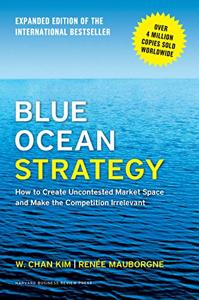
Want to learn the ideas in Blue Ocean Strategy better than ever? Read the world’s #1 book summary of Blue Ocean Strategy by W. Chan Kim here.
Read a brief 1-Page Summary or watch video summaries curated by our expert team. Note: this book guide is not affiliated with or endorsed by the publisher or author, and we always encourage you to purchase and read the full book.
Video Summaries of Blue Ocean Strategy
We’ve scoured the Internet for the very best videos on Blue Ocean Strategy, from high-quality videos summaries to interviews or commentary by W. Chan Kim.
1-Page Summary of Blue Ocean Strategy
Overview
Blue Ocean Strategy, Expanded Edition: How to Create Uncontested Market Space and Make the Competition Irrelevant is a handbook for business students and entrepreneurs who wish to rise above their competition. It offers insight into how they can become pioneers in previously uncharted market territory and gain access to impressive growth opportunities.
Most businesses make the mistake of focusing on their competitors when developing strategies. A “blue ocean” business, on the other hand, focuses on how to create new value for customers by creating a product or service that is different from what most companies in an industry offer. This strategy works because it creates demand in the marketplace and doesn’t require changing consumer behavior. The term “blue ocean” comes from the idea that an area of unexplored market space is like clear blue waters of an undisturbed portion of ocean. The opposite would be red oceans where there’s excessive competition and rivalry among businesses vying for profits.
Creating a new product or service is not enough. The company should create an innovative idea that consumers need and want, while being profitable for the business. It’s also important to execute it without resistance from other companies or people involved in the process. Additionally, these ideas can’t be their only source of income; they need to constantly innovate and find new ways to grow their business.
Key Takeaways
The blue ocean strategy is a way to create new markets for companies. They don’t have to compete with other companies in the same market space, but instead can create their own brand new markets.
Red ocean businesses focus on beating their competition. Blue ocean businesses, however, don’t worry about what the competition is doing. They ask themselves four questions: What are they doing? Why do they do it that way? How can we eliminate or improve upon that? And how will customers respond to our improvements or eliminations? Executing a blue ocean strategy successfully requires more than just making changes; one must also stick to the plan and be willing to make sacrifices for long-term success.
A blue ocean strategy is only profitable when it’s optimized.
Good leaders are able to overcome the obstacles that hinder their organization’s progress. Successful leaders must be good at strategy-making, because users and consumers are changing industries rapidly.
No company can sustain success without revising its long-term vision.
Key Takeaway 1: The blue ocean strategy empowers organizations to create entirely new markets for themselves instead of battling competitors in increasingly crowded territory.
An innovative business is one that creates value for the consumer. It doesn’t just compete with other businesses, but it offers something new and different to consumers. To create such a company, you must have a systematic approach to reducing costs and enhancing value while ensuring that the product or service is both useful and cost-efficient. Not every company needs to be an innovative innovator; some companies will always find success by focusing on their niche market rather than trying to break into an entirely new area of business.
Tesla Motors is a prime example of a business that operates in the blue ocean. In 2003, rather than attempt to beat established automakers including Ford, GM, and Chrysler, Tesla co-founder and CEO Elon Musk chose to develop value in an entirely innovative area. At that time, most car companies built electric and hybrid vehicles to be what the industry calls “compliance cars” developed merely to satisfy government regulations that they invest in green technologies as opposed to vehicles designed for consumers. Tesla was the first company to build an electric vehicle with consumer appeal; it has outperformed its gas-guzzling competitors by demonstrating speedier acceleration than Ferrari, Lamborghini or Bugatti.






